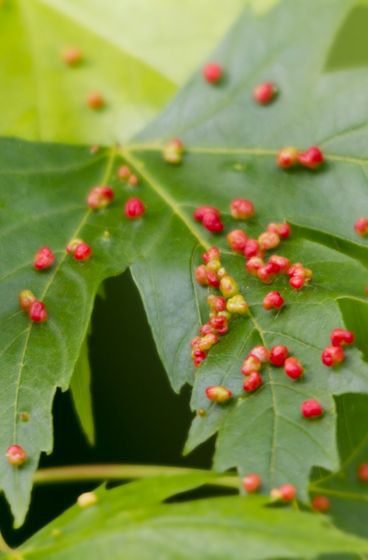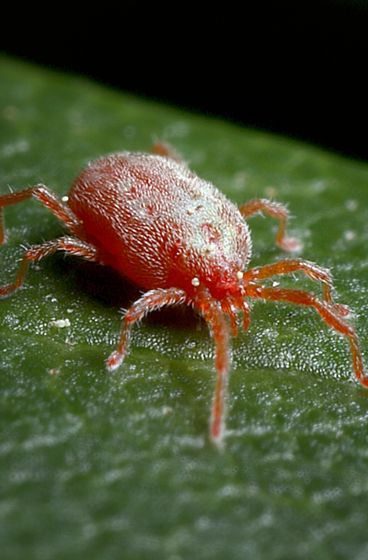They are smaller than the head of a pin, orange, green, red, brown, or even black in color, but despite their size, they cause significant damage to various types of plants. They are visible to the naked eye, but often, we have great difficulty in spotting them. Most commonly, before we can see the mites, we observe their fine webs on the stems and leaves, where they are attached along with their excrement, eggs, and a lot of dust.
The plant leaves become dotted with small discolored spots, often with a scraped appearance. The overall look appears grayish, brownish, or bronzed. Young leaves do not develop well and may appear small and even wrinkled and twisted. Some mites can be responsible for the formation of galls. Fruits may also have craters or spots that affect their appearance.

Gardeners who are not familiar with this pest may mistake them for insects and immediately reach for insecticides to combat them. However, mites belong to the arachnid family, just like spiders and ticks, and as such, they may be less sensitive to common insecticides. The correct technique for controlling and preventing mite infestations becomes crucial, especially in indoor plants and some highly susceptible species, such as desert roses.
When we notice our plants under attack by mites, we may have the mistaken idea that they don’t do much harm. After all, how can such tiny creatures negatively affect our plants? But mites are like a silent plague that spreads through the wind, multiplies rapidly, and before we know it, they have caused significant damage to the plants. Initially, we notice our plants looking dull and lacking luster, and suddenly the leaves turn yellow and fall prematurely. Only when we look closely with a magnifying glass do we see the fine webs where the mites scurry back and forth.
And make no mistake, controlling mite infestations is more challenging than it seems. They are quite resilient and prolific. Even if you have eliminated a large part of the population, if a few of them survive, you’ll soon have to start a new treatment. In ornamental plants, control should be especially intense since they make the plants look ugly and unsightly. In a garden or orchard, systematic controls are important, although we may not be as concerned about the plant’s aesthetics as long as it recovers and starts producing again. To top it off, some plant viruses are transmitted by mites. Another good reason to get rid of them.
So, controlling this common pest, even in apartments, is of utmost importance to maintain the beauty, vitality, and health of plants.
A wide variety of plants are susceptible to mite attacks. Among these, we can mention rose bushes, crotons, azaleas, impatiens, fruit trees, banana plants, begonias, desert roses, orchids, mint, lady palm, licuala, strawberry plants, jasmines, and many more indoor plants.

Before we devise our strategy to combat mites, we must consider that they have a very short life cycle. Some species can be born, grow, and reproduce within a short span of 3 days. The incubation of eggs takes about 10 days, depending on the species. Additionally, they may hibernate during the winter to reproduce again in the spring. The short life cycle implies that frequent sprays will be necessary. Another important aspect of the ecology of these arachnids is that they prefer dry and dusty environments. Thus, we can prevent their appearance and act synergistically in treating infested plants simply by increasing ambient humidity and the frequency of watering. Similarly, indoor plants can be protected from drafts and constant air conditioning, which favor the occurrence of the pest.
Regularly cleaning the leaves is also important, especially for indoor plants that are not exposed to rain. Take them outside for a regular shower or give them a cold shower. Large leaves can be wiped with a cloth, while small and delicate leaves can be sprayed with a warm water solution, adding a few drops of mild detergent to facilitate cleaning. Just be careful to change the cloth between plants to avoid the spread of pests and diseases.
You can also use repellent plants. You can plant them as a border around the beds you want to protect or make repellent solutions to apply to the plants. Plants that repel mites include onions, cloves, coriander, cinnamon, and rosemary. Keep your garden free of weeds. Many species of invasive plants act as hosts and become a constant source of contamination for the plants in our garden, orchard, or vegetable garden. Having said that, let’s move on to effective acaricidal and repellent solutions. Remember that any type of spray should be applied on cloudy days or in the late afternoon, during the cooler hours of the day. Use a sprayer and thoroughly drench the plants, especially the undersides of the leaves where they tend to hide.
The frequency of applications during the treatment of an infestation is every 3 days, with great discipline, to target adult mites. After controlling the infestation, make preventive applications every 15 days, and then monthly. Try to vary the control methods you use, always starting with the most natural and homemade methods, as mites easily develop resistance to the products used. The rotation of products is also beneficial for the plants, as one or another chemical substance may be toxic to them. This way, toxicity is diluted.

Before spraying plants with natural, homemade, or chemical products, test them on a small leaf and wait for 24 to 48 hours. If the leaf remains normal, proceed with the application on the entire plant. Otherwise, try another solution.
Mite Control Options:
- Periodic cleaning of the leaves with a warm water and mild detergent solution. Wipe large and sturdy leaves with a cloth, and spray delicate and small leaves. (Protect sensitive plants from the detergent).
- Raw Milk Solution: Mix 100 ml (3.5 fl oz) of raw milk (not from a carton or bag), with 900 ml (30.4 fl oz) of water, and regularly spray it on the plants.
- Alcohol-Vinegar Solution: Mix 200 ml (6.7 fl oz) of alcohol with 200 ml (6.7 fl oz) of vinegar and 1 liter (33.8 fl oz) of water. Spray it on the plants.
- Sulfur Solution: Mix 3 grams (0.1 oz) of soluble agricultural sulfur (found in the best garden centers and agricultural supply stores) in 1 liter (33.8 fl oz) of water, apply it with a sprayer on the plants. Do not spray on sulfur-sensitive plants, such as bromeliads.
- Hydrogen Peroxide Solution: Mix 10 ml (0.34 fl oz) of 20-volume hydrogen peroxide in 1 liter (33.8 fl oz) of water and spray it on the plants.
- Medicinal Soap Water Solution: Dilute two tablespoons of castile soap or sulfur soap shavings in 1 liter (33.8 fl oz) of water. Apply it with a sprayer.
- Isopropyl Alcohol Solution: Mix 200 ml (6.7 fl oz) of isopropyl alcohol (found in electronic product stores) in 1 liter (33.8 fl oz) of water. Apply with a cloth or sprayer.
- Medicinal Tea Solution: Boil 1 liter (33.8 fl oz) of water, and steep two tablespoons of crushed garlic, one tablespoon of cinnamon powder, one tablespoon of ground cloves, and one tablespoon of dried rosemary. After it cools, strain and immediately apply with a sprayer. Store the remaining solution in the refrigerator for up to 5 days (enough for two applications). This solution is excellent for plants sensitive to chemicals; it is fungicidal, bactericidal, and repels insects.
- Neem Oil Solution: Follow the product packaging instructions, as the concentration of neem oil varies by brand. Alternatively, you can buy ready-made neem oil spray at the best nurseries.
- Deltamethrin Solution: This should be used as a last resort and only in severe infestations. Deltamethrin is a potent acaricide, an agricultural pesticide that must be used with extreme caution. You can purchase it at agricultural supply stores and pet shops, as it is also used to control tick infestations. When using deltamethrin, it is important to wear personal protective equipment, including well-sealed clothing, gloves, masks, etc. Do not drink, eat, or smoke during application, and take a thorough shower after using the product. Apply under the guidance of an agronomist who will provide dilution instructions for each commercial form of the product. Do not apply to vegetables or orchards, especially during flowering or near harvest. This product is toxic to humans and animals, as well as harmful to the environment.

About Biological Control:
Many predator insects such as lacewings, thrips, and ladybugs can eliminate entire populations of mites if they have good reasons to stay in your garden. However, one of the main reasons for the recent growth in mite populations is the indiscriminate use of insecticides that destroy their natural predators. Therefore, avoid using insecticides regularly in your garden. This way, you protect beneficial and pollinating insects.
You can also use predatory mites, such as those from the genera Neoseiulus and Phytoseiulus, to control phytophagous mites (those that attack plants). Depending on the conditions, predatory mites can be very efficient in solving your mite problem. However, access to biological controls is often quite difficult for gardeners, whether amateur or professional, especially in small quantities and in urban areas. As a result, they are usually reserved for large-scale cultivation, such as commercial crops and orchards.


